Project Management Analysis and Risk Assessment: Camden Concert
VerifiedAdded on 2023/01/04
|9
|1983
|27
Project
AI Summary
This project management assignment analyzes the planning and execution of a musical concert organized by the Camden Sickle Cell and Thalassaemia Service Group. It begins with a network diagram analysis, identifying critical paths and potential cost implications. The project delves into stakeholder analysis, categorizing stakeholders based on their power and interest, and proposes management strategies for each group. A detailed work breakdown structure (WBS) is discussed, emphasizing its role in task organization and project control. The assignment then presents a comprehensive risk analysis, identifying potential risks such as noise pollution, pickpocketing, and drug use, along with mitigation strategies. The project outlines quality expectations, including sound and lighting standards, and acceptance criteria for project success. Finally, it explores appropriate project management methodologies, including Six Sigma, the Waterfall model, and Agile, assessing their applicability to the concert event and their potential benefits in terms of cost-effectiveness, phased execution, and stakeholder communication.
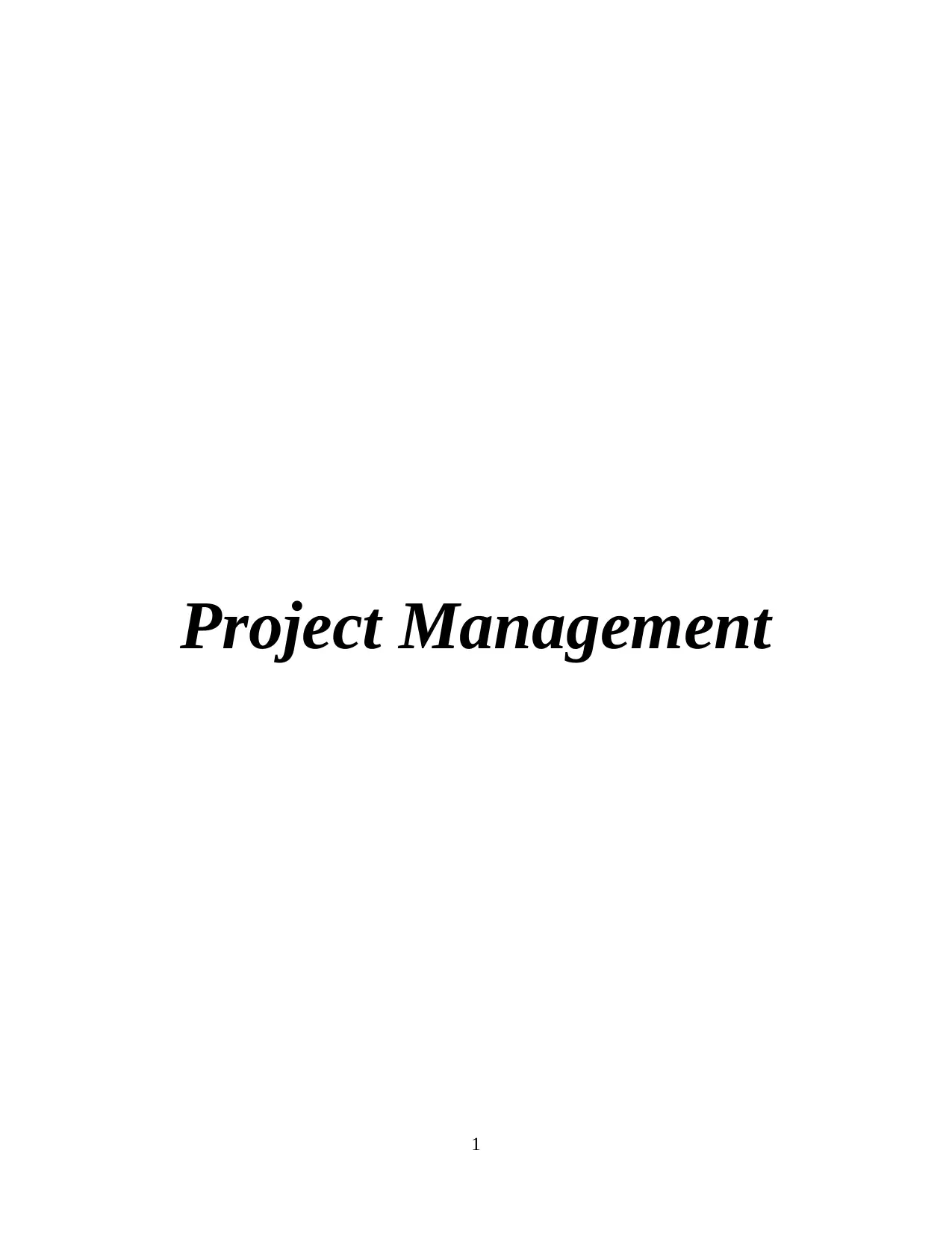
Project Management
1
1
Paraphrase This Document
Need a fresh take? Get an instant paraphrase of this document with our AI Paraphraser
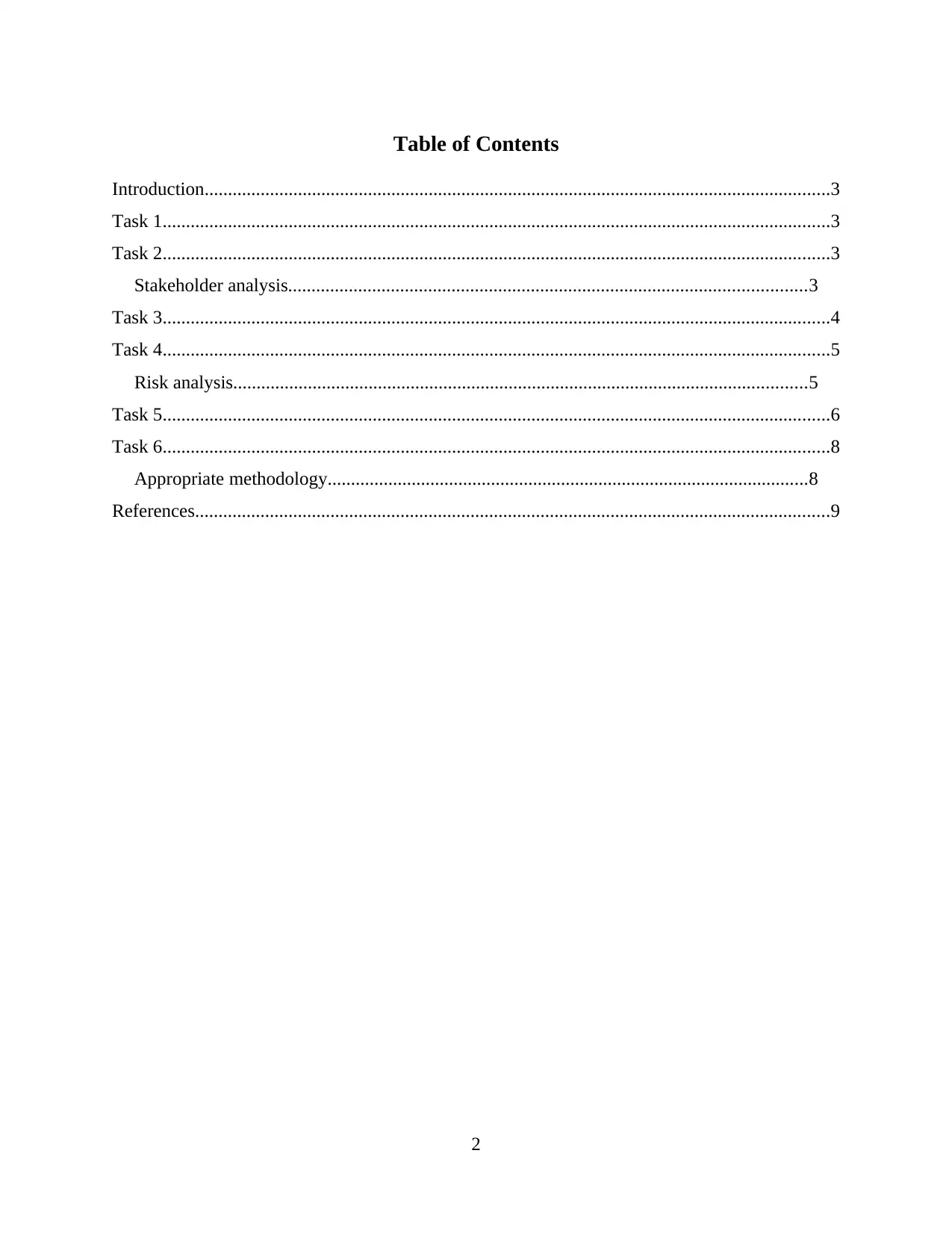
Table of Contents
Introduction......................................................................................................................................3
Task 1...............................................................................................................................................3
Task 2...............................................................................................................................................3
Stakeholder analysis...............................................................................................................3
Task 3...............................................................................................................................................4
Task 4...............................................................................................................................................5
Risk analysis...........................................................................................................................5
Task 5...............................................................................................................................................6
Task 6...............................................................................................................................................8
Appropriate methodology.......................................................................................................8
References........................................................................................................................................9
2
Introduction......................................................................................................................................3
Task 1...............................................................................................................................................3
Task 2...............................................................................................................................................3
Stakeholder analysis...............................................................................................................3
Task 3...............................................................................................................................................4
Task 4...............................................................................................................................................5
Risk analysis...........................................................................................................................5
Task 5...............................................................................................................................................6
Task 6...............................................................................................................................................8
Appropriate methodology.......................................................................................................8
References........................................................................................................................................9
2
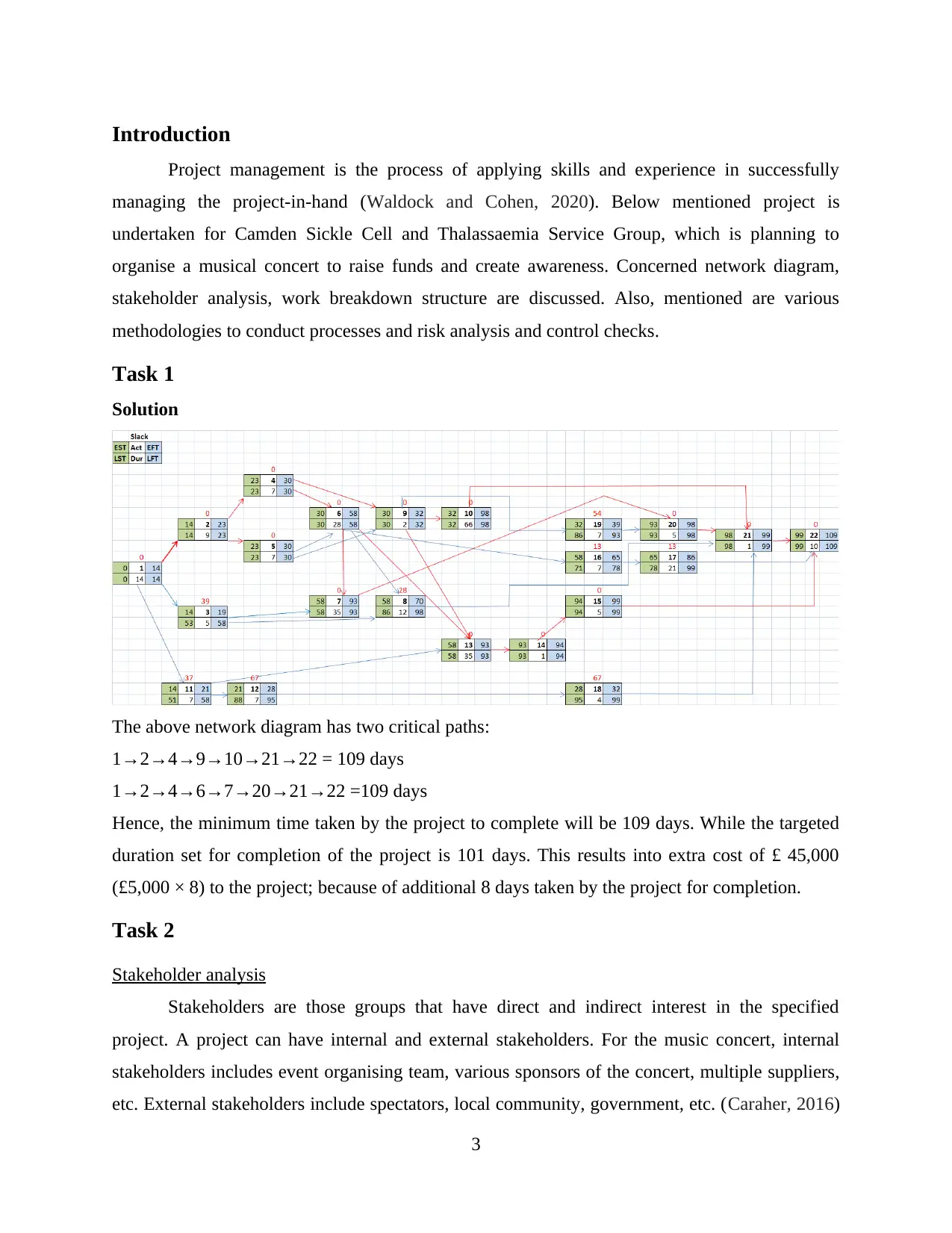
Introduction
Project management is the process of applying skills and experience in successfully
managing the project-in-hand (Waldock and Cohen, 2020). Below mentioned project is
undertaken for Camden Sickle Cell and Thalassaemia Service Group, which is planning to
organise a musical concert to raise funds and create awareness. Concerned network diagram,
stakeholder analysis, work breakdown structure are discussed. Also, mentioned are various
methodologies to conduct processes and risk analysis and control checks.
Task 1
Solution
The above network diagram has two critical paths:
1→2→4→9→10→21→22 = 109 days
1→2→4→6→7→20→21→22 =109 days
Hence, the minimum time taken by the project to complete will be 109 days. While the targeted
duration set for completion of the project is 101 days. This results into extra cost of £ 45,000
(£5,000 × 8) to the project; because of additional 8 days taken by the project for completion.
Task 2
Stakeholder analysis
Stakeholders are those groups that have direct and indirect interest in the specified
project. A project can have internal and external stakeholders. For the music concert, internal
stakeholders includes event organising team, various sponsors of the concert, multiple suppliers,
etc. External stakeholders include spectators, local community, government, etc. (Caraher, 2016)
3
Project management is the process of applying skills and experience in successfully
managing the project-in-hand (Waldock and Cohen, 2020). Below mentioned project is
undertaken for Camden Sickle Cell and Thalassaemia Service Group, which is planning to
organise a musical concert to raise funds and create awareness. Concerned network diagram,
stakeholder analysis, work breakdown structure are discussed. Also, mentioned are various
methodologies to conduct processes and risk analysis and control checks.
Task 1
Solution
The above network diagram has two critical paths:
1→2→4→9→10→21→22 = 109 days
1→2→4→6→7→20→21→22 =109 days
Hence, the minimum time taken by the project to complete will be 109 days. While the targeted
duration set for completion of the project is 101 days. This results into extra cost of £ 45,000
(£5,000 × 8) to the project; because of additional 8 days taken by the project for completion.
Task 2
Stakeholder analysis
Stakeholders are those groups that have direct and indirect interest in the specified
project. A project can have internal and external stakeholders. For the music concert, internal
stakeholders includes event organising team, various sponsors of the concert, multiple suppliers,
etc. External stakeholders include spectators, local community, government, etc. (Caraher, 2016)
3
⊘ This is a preview!⊘
Do you want full access?
Subscribe today to unlock all pages.

Trusted by 1+ million students worldwide
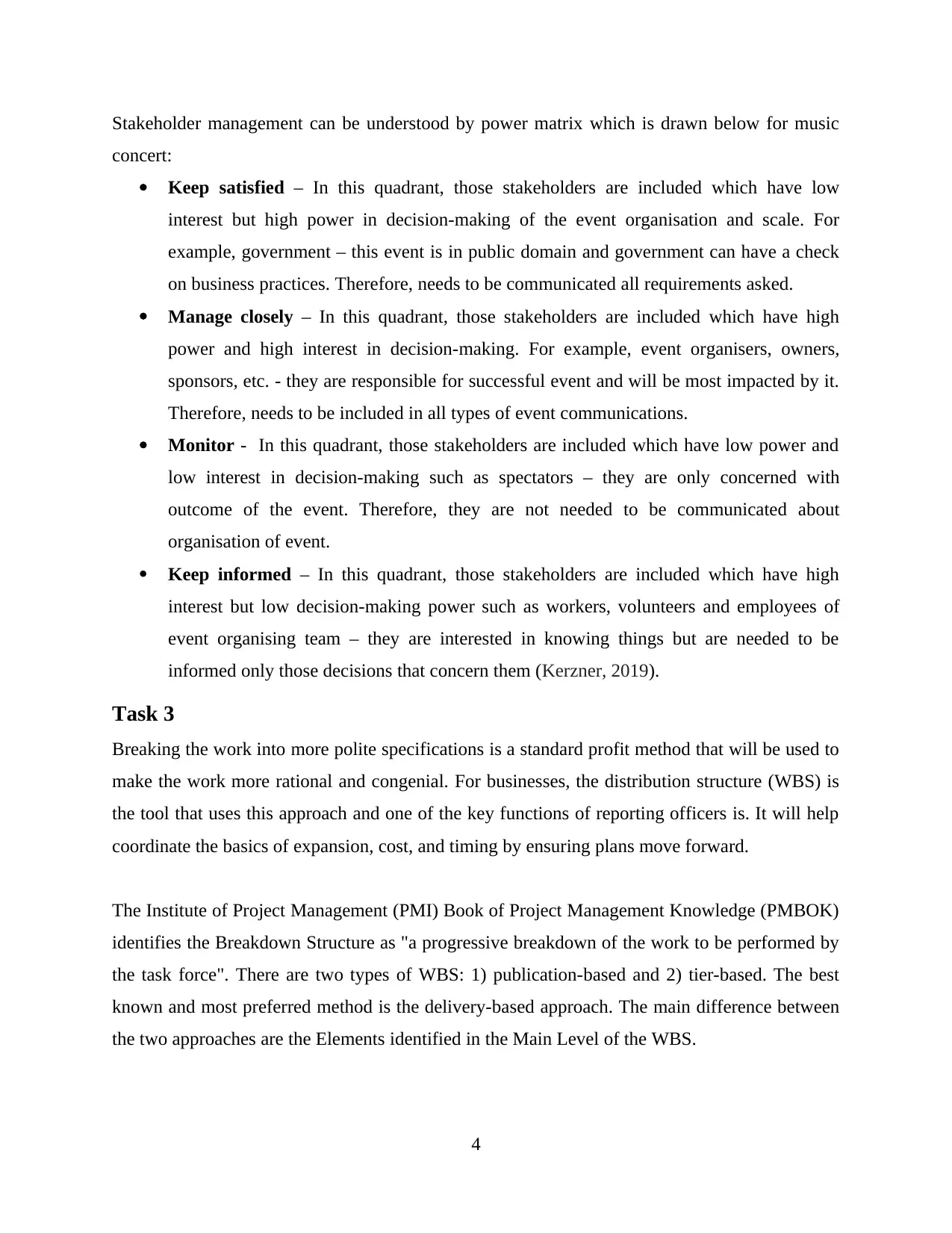
Stakeholder management can be understood by power matrix which is drawn below for music
concert:
Keep satisfied – In this quadrant, those stakeholders are included which have low
interest but high power in decision-making of the event organisation and scale. For
example, government – this event is in public domain and government can have a check
on business practices. Therefore, needs to be communicated all requirements asked.
Manage closely – In this quadrant, those stakeholders are included which have high
power and high interest in decision-making. For example, event organisers, owners,
sponsors, etc. - they are responsible for successful event and will be most impacted by it.
Therefore, needs to be included in all types of event communications.
Monitor - In this quadrant, those stakeholders are included which have low power and
low interest in decision-making such as spectators – they are only concerned with
outcome of the event. Therefore, they are not needed to be communicated about
organisation of event.
Keep informed – In this quadrant, those stakeholders are included which have high
interest but low decision-making power such as workers, volunteers and employees of
event organising team – they are interested in knowing things but are needed to be
informed only those decisions that concern them (Kerzner, 2019).
Task 3
Breaking the work into more polite specifications is a standard profit method that will be used to
make the work more rational and congenial. For businesses, the distribution structure (WBS) is
the tool that uses this approach and one of the key functions of reporting officers is. It will help
coordinate the basics of expansion, cost, and timing by ensuring plans move forward.
The Institute of Project Management (PMI) Book of Project Management Knowledge (PMBOK)
identifies the Breakdown Structure as "a progressive breakdown of the work to be performed by
the task force". There are two types of WBS: 1) publication-based and 2) tier-based. The best
known and most preferred method is the delivery-based approach. The main difference between
the two approaches are the Elements identified in the Main Level of the WBS.
4
concert:
Keep satisfied – In this quadrant, those stakeholders are included which have low
interest but high power in decision-making of the event organisation and scale. For
example, government – this event is in public domain and government can have a check
on business practices. Therefore, needs to be communicated all requirements asked.
Manage closely – In this quadrant, those stakeholders are included which have high
power and high interest in decision-making. For example, event organisers, owners,
sponsors, etc. - they are responsible for successful event and will be most impacted by it.
Therefore, needs to be included in all types of event communications.
Monitor - In this quadrant, those stakeholders are included which have low power and
low interest in decision-making such as spectators – they are only concerned with
outcome of the event. Therefore, they are not needed to be communicated about
organisation of event.
Keep informed – In this quadrant, those stakeholders are included which have high
interest but low decision-making power such as workers, volunteers and employees of
event organising team – they are interested in knowing things but are needed to be
informed only those decisions that concern them (Kerzner, 2019).
Task 3
Breaking the work into more polite specifications is a standard profit method that will be used to
make the work more rational and congenial. For businesses, the distribution structure (WBS) is
the tool that uses this approach and one of the key functions of reporting officers is. It will help
coordinate the basics of expansion, cost, and timing by ensuring plans move forward.
The Institute of Project Management (PMI) Book of Project Management Knowledge (PMBOK)
identifies the Breakdown Structure as "a progressive breakdown of the work to be performed by
the task force". There are two types of WBS: 1) publication-based and 2) tier-based. The best
known and most preferred method is the delivery-based approach. The main difference between
the two approaches are the Elements identified in the Main Level of the WBS.
4
Paraphrase This Document
Need a fresh take? Get an instant paraphrase of this document with our AI Paraphraser
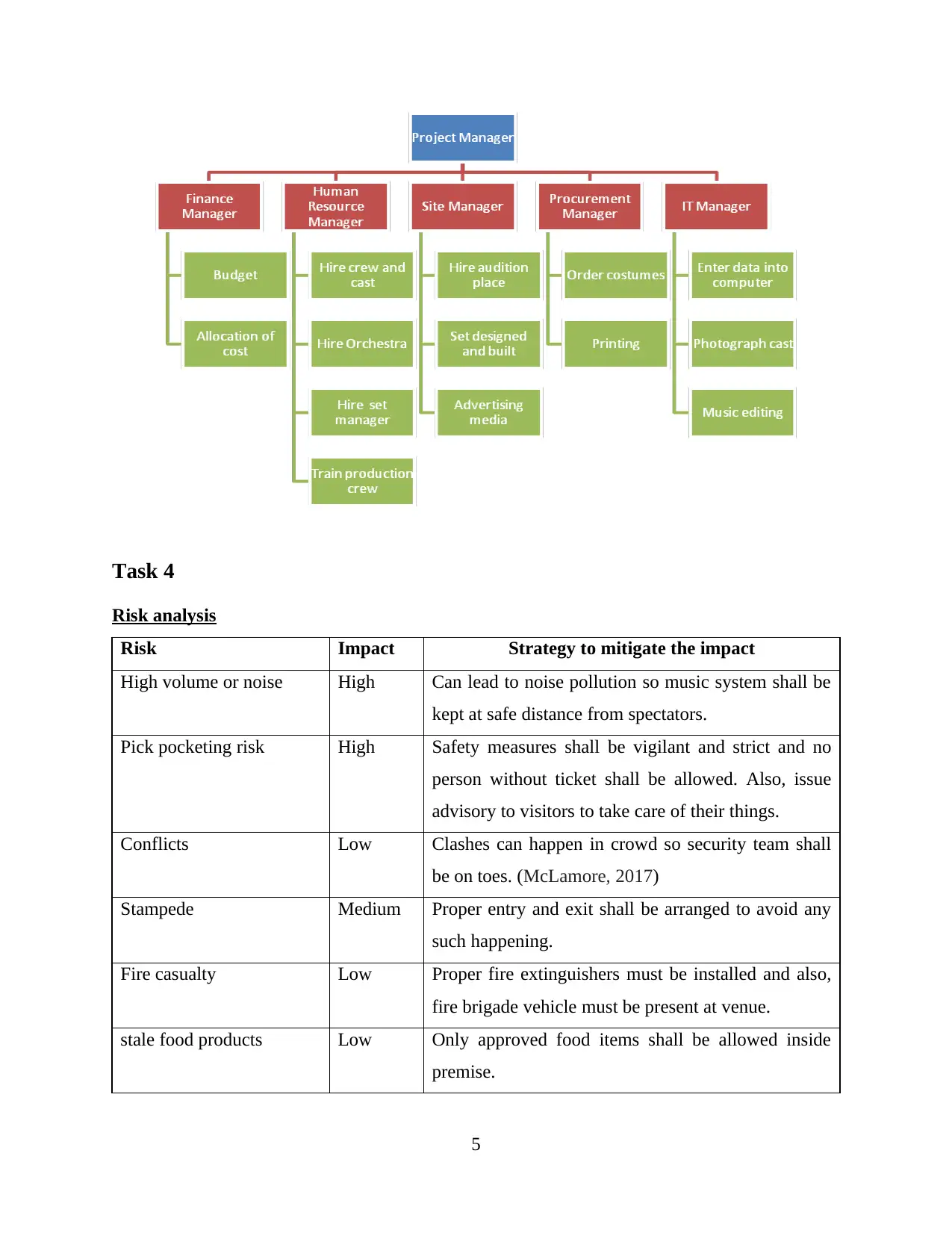
Task 4
Risk analysis
Risk Impact Strategy to mitigate the impact
High volume or noise High Can lead to noise pollution so music system shall be
kept at safe distance from spectators.
Pick pocketing risk High Safety measures shall be vigilant and strict and no
person without ticket shall be allowed. Also, issue
advisory to visitors to take care of their things.
Conflicts Low Clashes can happen in crowd so security team shall
be on toes. (McLamore, 2017)
Stampede Medium Proper entry and exit shall be arranged to avoid any
such happening.
Fire casualty Low Proper fire extinguishers must be installed and also,
fire brigade vehicle must be present at venue.
stale food products Low Only approved food items shall be allowed inside
premise.
5
Risk analysis
Risk Impact Strategy to mitigate the impact
High volume or noise High Can lead to noise pollution so music system shall be
kept at safe distance from spectators.
Pick pocketing risk High Safety measures shall be vigilant and strict and no
person without ticket shall be allowed. Also, issue
advisory to visitors to take care of their things.
Conflicts Low Clashes can happen in crowd so security team shall
be on toes. (McLamore, 2017)
Stampede Medium Proper entry and exit shall be arranged to avoid any
such happening.
Fire casualty Low Proper fire extinguishers must be installed and also,
fire brigade vehicle must be present at venue.
stale food products Low Only approved food items shall be allowed inside
premise.
5
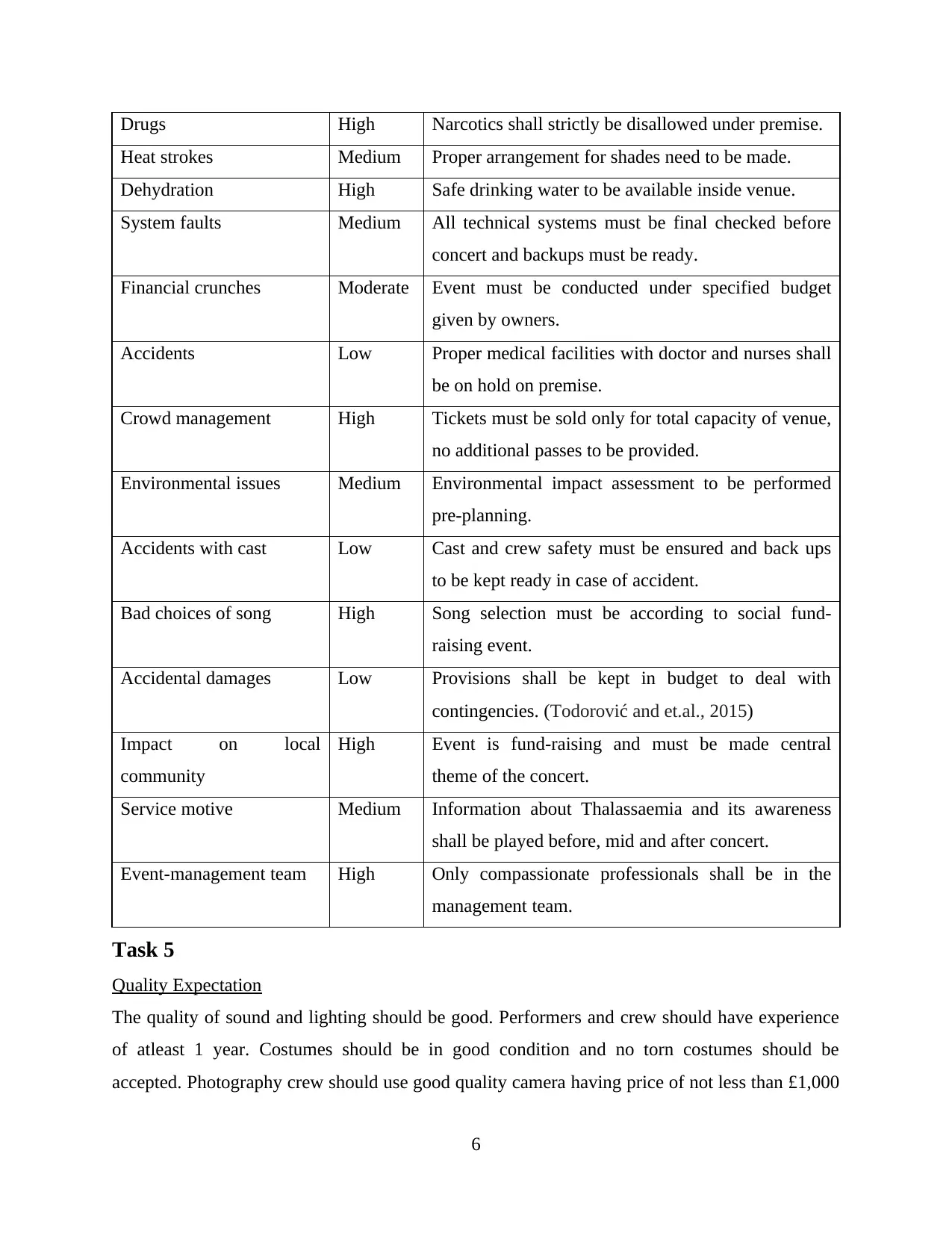
Drugs High Narcotics shall strictly be disallowed under premise.
Heat strokes Medium Proper arrangement for shades need to be made.
Dehydration High Safe drinking water to be available inside venue.
System faults Medium All technical systems must be final checked before
concert and backups must be ready.
Financial crunches Moderate Event must be conducted under specified budget
given by owners.
Accidents Low Proper medical facilities with doctor and nurses shall
be on hold on premise.
Crowd management High Tickets must be sold only for total capacity of venue,
no additional passes to be provided.
Environmental issues Medium Environmental impact assessment to be performed
pre-planning.
Accidents with cast Low Cast and crew safety must be ensured and back ups
to be kept ready in case of accident.
Bad choices of song High Song selection must be according to social fund-
raising event.
Accidental damages Low Provisions shall be kept in budget to deal with
contingencies. (Todorović and et.al., 2015)
Impact on local
community
High Event is fund-raising and must be made central
theme of the concert.
Service motive Medium Information about Thalassaemia and its awareness
shall be played before, mid and after concert.
Event-management team High Only compassionate professionals shall be in the
management team.
Task 5
Quality Expectation
The quality of sound and lighting should be good. Performers and crew should have experience
of atleast 1 year. Costumes should be in good condition and no torn costumes should be
accepted. Photography crew should use good quality camera having price of not less than £1,000
6
Heat strokes Medium Proper arrangement for shades need to be made.
Dehydration High Safe drinking water to be available inside venue.
System faults Medium All technical systems must be final checked before
concert and backups must be ready.
Financial crunches Moderate Event must be conducted under specified budget
given by owners.
Accidents Low Proper medical facilities with doctor and nurses shall
be on hold on premise.
Crowd management High Tickets must be sold only for total capacity of venue,
no additional passes to be provided.
Environmental issues Medium Environmental impact assessment to be performed
pre-planning.
Accidents with cast Low Cast and crew safety must be ensured and back ups
to be kept ready in case of accident.
Bad choices of song High Song selection must be according to social fund-
raising event.
Accidental damages Low Provisions shall be kept in budget to deal with
contingencies. (Todorović and et.al., 2015)
Impact on local
community
High Event is fund-raising and must be made central
theme of the concert.
Service motive Medium Information about Thalassaemia and its awareness
shall be played before, mid and after concert.
Event-management team High Only compassionate professionals shall be in the
management team.
Task 5
Quality Expectation
The quality of sound and lighting should be good. Performers and crew should have experience
of atleast 1 year. Costumes should be in good condition and no torn costumes should be
accepted. Photography crew should use good quality camera having price of not less than £1,000
6
⊘ This is a preview!⊘
Do you want full access?
Subscribe today to unlock all pages.

Trusted by 1+ million students worldwide
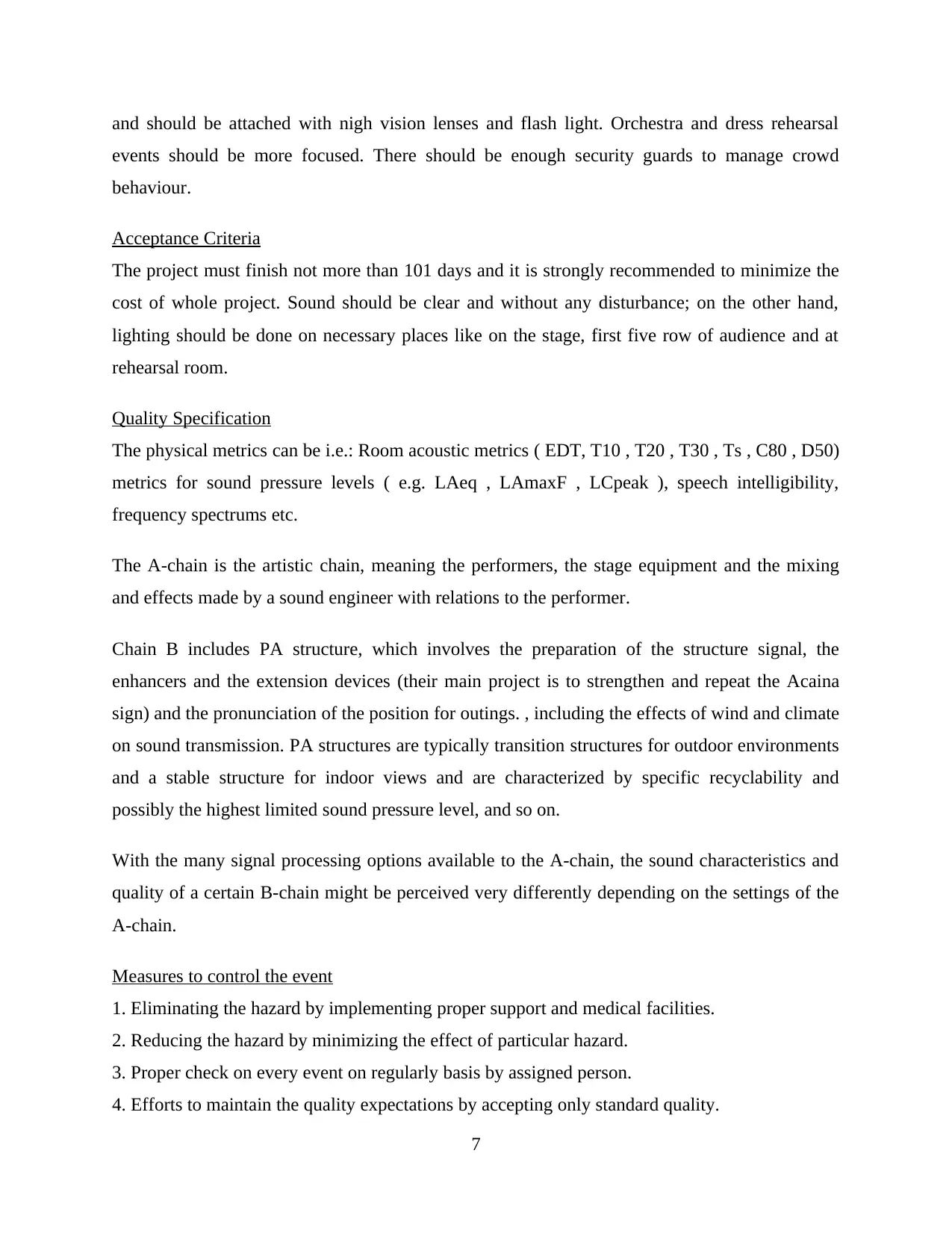
and should be attached with nigh vision lenses and flash light. Orchestra and dress rehearsal
events should be more focused. There should be enough security guards to manage crowd
behaviour.
Acceptance Criteria
The project must finish not more than 101 days and it is strongly recommended to minimize the
cost of whole project. Sound should be clear and without any disturbance; on the other hand,
lighting should be done on necessary places like on the stage, first five row of audience and at
rehearsal room.
Quality Specification
The physical metrics can be i.e.: Room acoustic metrics ( EDT, T10 , T20 , T30 , Ts , C80 , D50)
metrics for sound pressure levels ( e.g. LAeq , LAmaxF , LCpeak ), speech intelligibility,
frequency spectrums etc.
The A-chain is the artistic chain, meaning the performers, the stage equipment and the mixing
and effects made by a sound engineer with relations to the performer.
Chain B includes PA structure, which involves the preparation of the structure signal, the
enhancers and the extension devices (their main project is to strengthen and repeat the Acaina
sign) and the pronunciation of the position for outings. , including the effects of wind and climate
on sound transmission. PA structures are typically transition structures for outdoor environments
and a stable structure for indoor views and are characterized by specific recyclability and
possibly the highest limited sound pressure level, and so on.
With the many signal processing options available to the A-chain, the sound characteristics and
quality of a certain B-chain might be perceived very differently depending on the settings of the
A-chain.
Measures to control the event
1. Eliminating the hazard by implementing proper support and medical facilities.
2. Reducing the hazard by minimizing the effect of particular hazard.
3. Proper check on every event on regularly basis by assigned person.
4. Efforts to maintain the quality expectations by accepting only standard quality.
7
events should be more focused. There should be enough security guards to manage crowd
behaviour.
Acceptance Criteria
The project must finish not more than 101 days and it is strongly recommended to minimize the
cost of whole project. Sound should be clear and without any disturbance; on the other hand,
lighting should be done on necessary places like on the stage, first five row of audience and at
rehearsal room.
Quality Specification
The physical metrics can be i.e.: Room acoustic metrics ( EDT, T10 , T20 , T30 , Ts , C80 , D50)
metrics for sound pressure levels ( e.g. LAeq , LAmaxF , LCpeak ), speech intelligibility,
frequency spectrums etc.
The A-chain is the artistic chain, meaning the performers, the stage equipment and the mixing
and effects made by a sound engineer with relations to the performer.
Chain B includes PA structure, which involves the preparation of the structure signal, the
enhancers and the extension devices (their main project is to strengthen and repeat the Acaina
sign) and the pronunciation of the position for outings. , including the effects of wind and climate
on sound transmission. PA structures are typically transition structures for outdoor environments
and a stable structure for indoor views and are characterized by specific recyclability and
possibly the highest limited sound pressure level, and so on.
With the many signal processing options available to the A-chain, the sound characteristics and
quality of a certain B-chain might be perceived very differently depending on the settings of the
A-chain.
Measures to control the event
1. Eliminating the hazard by implementing proper support and medical facilities.
2. Reducing the hazard by minimizing the effect of particular hazard.
3. Proper check on every event on regularly basis by assigned person.
4. Efforts to maintain the quality expectations by accepting only standard quality.
7
Paraphrase This Document
Need a fresh take? Get an instant paraphrase of this document with our AI Paraphraser
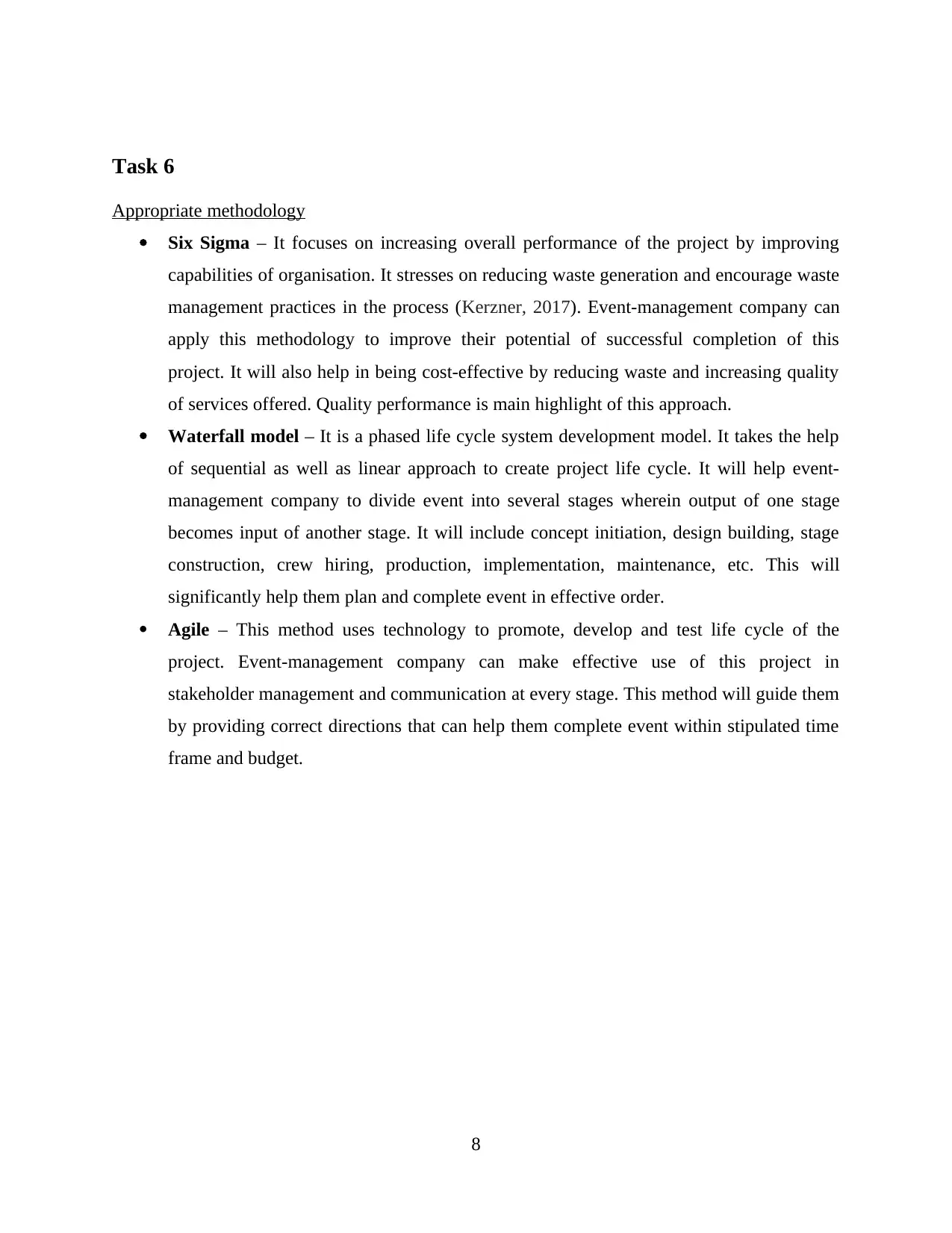
Task 6
Appropriate methodology
Six Sigma – It focuses on increasing overall performance of the project by improving
capabilities of organisation. It stresses on reducing waste generation and encourage waste
management practices in the process (Kerzner, 2017). Event-management company can
apply this methodology to improve their potential of successful completion of this
project. It will also help in being cost-effective by reducing waste and increasing quality
of services offered. Quality performance is main highlight of this approach.
Waterfall model – It is a phased life cycle system development model. It takes the help
of sequential as well as linear approach to create project life cycle. It will help event-
management company to divide event into several stages wherein output of one stage
becomes input of another stage. It will include concept initiation, design building, stage
construction, crew hiring, production, implementation, maintenance, etc. This will
significantly help them plan and complete event in effective order.
Agile – This method uses technology to promote, develop and test life cycle of the
project. Event-management company can make effective use of this project in
stakeholder management and communication at every stage. This method will guide them
by providing correct directions that can help them complete event within stipulated time
frame and budget.
8
Appropriate methodology
Six Sigma – It focuses on increasing overall performance of the project by improving
capabilities of organisation. It stresses on reducing waste generation and encourage waste
management practices in the process (Kerzner, 2017). Event-management company can
apply this methodology to improve their potential of successful completion of this
project. It will also help in being cost-effective by reducing waste and increasing quality
of services offered. Quality performance is main highlight of this approach.
Waterfall model – It is a phased life cycle system development model. It takes the help
of sequential as well as linear approach to create project life cycle. It will help event-
management company to divide event into several stages wherein output of one stage
becomes input of another stage. It will include concept initiation, design building, stage
construction, crew hiring, production, implementation, maintenance, etc. This will
significantly help them plan and complete event in effective order.
Agile – This method uses technology to promote, develop and test life cycle of the
project. Event-management company can make effective use of this project in
stakeholder management and communication at every stage. This method will guide them
by providing correct directions that can help them complete event within stipulated time
frame and budget.
8
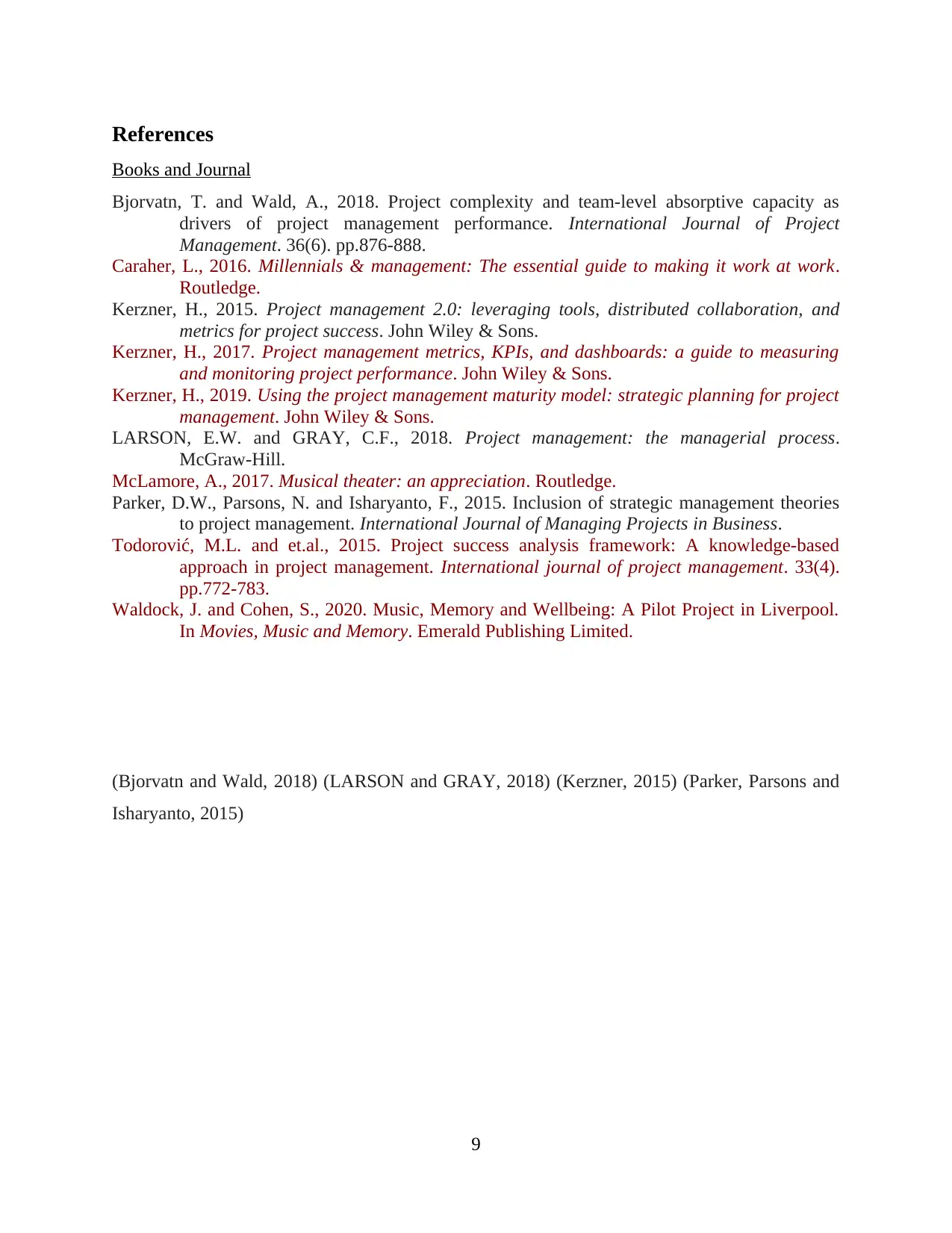
References
Books and Journal
Bjorvatn, T. and Wald, A., 2018. Project complexity and team-level absorptive capacity as
drivers of project management performance. International Journal of Project
Management. 36(6). pp.876-888.
Caraher, L., 2016. Millennials & management: The essential guide to making it work at work.
Routledge.
Kerzner, H., 2015. Project management 2.0: leveraging tools, distributed collaboration, and
metrics for project success. John Wiley & Sons.
Kerzner, H., 2017. Project management metrics, KPIs, and dashboards: a guide to measuring
and monitoring project performance. John Wiley & Sons.
Kerzner, H., 2019. Using the project management maturity model: strategic planning for project
management. John Wiley & Sons.
LARSON, E.W. and GRAY, C.F., 2018. Project management: the managerial process.
McGraw-Hill.
McLamore, A., 2017. Musical theater: an appreciation. Routledge.
Parker, D.W., Parsons, N. and Isharyanto, F., 2015. Inclusion of strategic management theories
to project management. International Journal of Managing Projects in Business.
Todorović, M.L. and et.al., 2015. Project success analysis framework: A knowledge-based
approach in project management. International journal of project management. 33(4).
pp.772-783.
Waldock, J. and Cohen, S., 2020. Music, Memory and Wellbeing: A Pilot Project in Liverpool.
In Movies, Music and Memory. Emerald Publishing Limited.
(Bjorvatn and Wald, 2018) (LARSON and GRAY, 2018) (Kerzner, 2015) (Parker, Parsons and
Isharyanto, 2015)
9
Books and Journal
Bjorvatn, T. and Wald, A., 2018. Project complexity and team-level absorptive capacity as
drivers of project management performance. International Journal of Project
Management. 36(6). pp.876-888.
Caraher, L., 2016. Millennials & management: The essential guide to making it work at work.
Routledge.
Kerzner, H., 2015. Project management 2.0: leveraging tools, distributed collaboration, and
metrics for project success. John Wiley & Sons.
Kerzner, H., 2017. Project management metrics, KPIs, and dashboards: a guide to measuring
and monitoring project performance. John Wiley & Sons.
Kerzner, H., 2019. Using the project management maturity model: strategic planning for project
management. John Wiley & Sons.
LARSON, E.W. and GRAY, C.F., 2018. Project management: the managerial process.
McGraw-Hill.
McLamore, A., 2017. Musical theater: an appreciation. Routledge.
Parker, D.W., Parsons, N. and Isharyanto, F., 2015. Inclusion of strategic management theories
to project management. International Journal of Managing Projects in Business.
Todorović, M.L. and et.al., 2015. Project success analysis framework: A knowledge-based
approach in project management. International journal of project management. 33(4).
pp.772-783.
Waldock, J. and Cohen, S., 2020. Music, Memory and Wellbeing: A Pilot Project in Liverpool.
In Movies, Music and Memory. Emerald Publishing Limited.
(Bjorvatn and Wald, 2018) (LARSON and GRAY, 2018) (Kerzner, 2015) (Parker, Parsons and
Isharyanto, 2015)
9
⊘ This is a preview!⊘
Do you want full access?
Subscribe today to unlock all pages.

Trusted by 1+ million students worldwide
1 out of 9
Related Documents
Your All-in-One AI-Powered Toolkit for Academic Success.
+13062052269
info@desklib.com
Available 24*7 on WhatsApp / Email
![[object Object]](/_next/static/media/star-bottom.7253800d.svg)
Unlock your academic potential
Copyright © 2020–2025 A2Z Services. All Rights Reserved. Developed and managed by ZUCOL.





